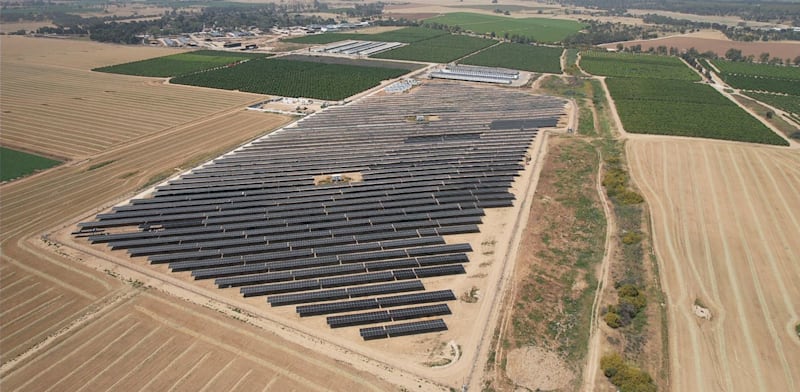
In a close vote, the Committee for the Preservation of Agricultural Land and Open Spaces has ruled out plans for constructing solar fields at an investment of over NIS 100 million in four kibbutzim in the Gaza Strip border area. The rejection of the plans is contrary to decisions by the Israel Land Authority in November 2023, and will impede the lowering of electricity prices that projects of this kind could bring about.
The committee, which is part of the Planning Administration, justified its decision on the grounds that the Tekuma region “is the granary of Israel”, and the Ministry of Agriculture also insists that construction of solar fields harms the future of local agriculture. For their part, the Ministry of Finance and the Israel Land Authority are pushing for the use of solar fields in order to meet Israel’s targets for power production from renewable sources.
In the background is a dispute in principle on the land usage mix: whether it is right to construct outright solar fields, or whether to prefer dual-use models (agri-voltaic) for growing agricultural produce under solar panels that are more expensive to construct and maintain.
“After October 7, as part of the state’s wish to benefit the Gaza border settlements, the Israel Land Authority decided to allow them to construct more solar fields. The quota rose from 250 dunams to 400 dunams,” says Assaf Bavli, economic coordinator of Kibbutz Magen.
“We put forward a solar plan, and came to the District Planning and Building Committee. It approved the plan, but said that a decision was required from the Committee for the Preservation of Agricultural Land and Open Spaces,” says Bavli. As mentioned, that committee rejected the plan. It approved the 250 dunam allocation from before the war, but insisted that the rest had to come in addition to agriculture (dual-use) and not at its expense. That decision also put an end to similar plans by Kibbutz Ein Hashlosha, Kibbutz Nir Yitzhak, and Kibbutz Erez, which is close to the northern Gaza Strip. According to market estimates, expansion of the solar field allocation would have meant NIS 1-2 million revenue annually to each of the settlements, from renting out the land.
On paper, the dual-use systems are an ideal solution, combining energy production and agriculture, but Bavli says that “it’s not good to mix them.” In this context, the National Economic Council in the Prime Minister’s Office published a report in September 2024 that found that, in order to make significant progress in implementing power production from renewable sources, large solar fields should be constructed in the Negev alongside dual-use areas. According to the report, the cost per kilowatt of constructing a conventional solar field is NIS 2,000, versus NIS 4,500 in dual-use, agri-voltaic projects.
Finance Ministry takes sides
The government decision in December also stated that in settlements in the “Tekuma” area in which settlements are being rehabilitated after the October 7 attack, “advanced energy solutions” should be built. Significant projects were approved for several kibbutzim, including Kfar Aza, Kissufim, and Nir Oz, but when the Tekuma administration examined the matter in April 2024, it chose to be evasive: “The range of relevant considerations… and the required balance for preserving open spaces and the agricultural character of the area should be taken into account.”
Meanwhile, the Ministry of Finance has taken sides. In December, the ministry demanded that the Planning Administration should advance solar installations “that facilitate electricity production in high volumes and at low cost.” According to the Ministry of Finance, 65% of Israel solar power output is already produced from dual-use systems, and there is no justification for ruling out the cheap conventional alternative. This stance won official backing in session of the Planning Administration where it was decided that “plans for land-based installations will not be dismissed out of hand.”
Against them, the Ministry of Agriculture has taken the opposite stance. In an official statement in July, it said, “To the extent that the land in the plan is suitable and can be farmed, it should be preserved, and only dual-use installations should be allowed.”
Raanan Amoyal, head of the Ministry of Agriculture Planning Department, says, “The basis of agricultural production, which is the land, is being harmed on a huge scale.” Amoyal fears a real food shortage in the future. “It’s difficult, but the country has to look to its land resources. You can’t ignore agriculture and look only at energy,” he says.
The Committee for the Preservation of Agricultural Land and Open Spaces stated in response to the report: “The committee has regard for the preservation of the Tekuma region as the granary and produce resource of the State of Israel. For that reason, and in accordance with national planning policy, the committee gives priority to agri-voltaic installations that permit dual use of the land for agricultural crops and energy production, in preference to photo-voltaic installations that prevent any agricultural use of the land and thus harm open spaces, agricultural land, and food security. Accordingly, and in order to find a balance between all of the needs, the committee allocated 250 dunams to each settlement for construction of photo-voltaic installations, while the rest of the land will be zoned for agri-voltaic installations that can facilitate growing agricultural crops alongside energy production.”
Published by Globes, Israel business news – en.globes.co.il – on July 16, 2025.
© Copyright of Globes Publisher Itonut (1983) Ltd., 2025.






